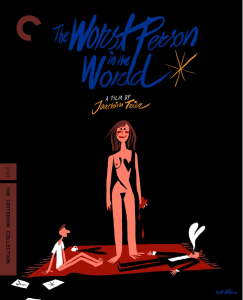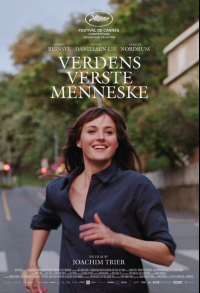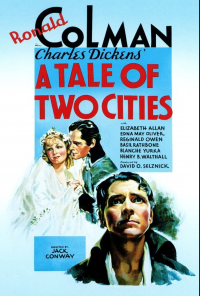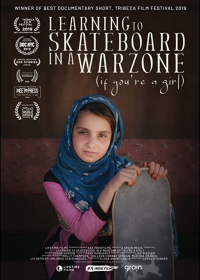




This week, Jeff Godsil revisits A Tale of Two Cities, while Matthew of KBOO's monthly bedtime story program Gremlin Time revisits A Hard Day's Night, and Britta Gordon looks at the timely Learning to Skateboard in a Warzone (If You're a Girl), Carol Dysinger's Oscar-winning documentary from 2019. In our DVD corner, we cover the new Criterion DVD of The Worst Person in the World, Joachim Trier's film from 2021.
––––––––––––––––––––––––––––––––––––––––––––––––––––––
The text of our review of Worst Person in the World
Though when we think of movies, we often think of the beauty of nature found in westerns, or the road film in which vast stationary vistas contrast with the tiny wanderers overwhelmed by the landscape. But most movies, including the very first films ever made, are about cities. It's not a matter of convenience, it's a matter of a sharp shift in the location of civilizations. But this also leads to a certain landscape-like beauty discovered in the cityscape by filmmakers from Charles Chaplin to Dziga Vertov to Chris Marker. They have made cities beautiful in their comedies and film essays. It can be a love-hate relationship, however, as in the 1970s we were offered tales of frustration in New York City, if not terror, while film noir created an environment in which the weak-willed were imperiled. Joachim Trier is only the latest filmmaker to have a love affair – with doubts – about a city, in this case, Oslo, Norway, the location of his Oslo trilogy, recently completed with the film, The Worst Person in the World.
Worst Person is in the tradition of the early ‘60s, films such as Chloe from 5 to 7, and Antonioni’s La notte, Malle’s Elevator to the Gallows, one of the first films which follows a women in Paris, and others, all films studying women as they walked aimlessly through the city, killing time, or thinking about their lives. As in those films, Julie, the main subject of this character study, spends a lot of time alone in the streets in Oslo wondering, pondering, why she is the way she is.
I've only read a few reviews of the film, and so far haven't found anyone who really captures this movie, which I found one of the most discomforting and disquieting films I've seen in a long time. As it follows Julie on each side of her 30th birthday we see her good sides or bad sides or infuriating sides, and her self-destructive sides, making her, though admittedly the beneficiary of white privilege, a fully fleshed-out person, whom sometimes you like, and sometimes you don't, as she struggles to find herself, or know herself, or just figure out what she wants to do with her life.
She ends up with two long-term relationships in the film, the first, with a older cartoonist, famous for an underground, character, called Gaupe, which means lynx in Norwegian, and is translated here as Bobcat, clearly based on R Crumb’s Fritz the Cat, another cartoon character whose scruffy existence is neutralized by an animated film adaptation.
Her second relationship begins when she abandons her boyfriend at a book signing party, and then crashes a wedding reception and she spends the entire evening flirting with one of the guests, who turns out to be a barista somewhere in the city, but also closer to her own age, and who like her is himself already in a relationship. It's a difficult match because his mate is a social justice warrior and he feels as if he can't live up to her lifestyle expectations. There is a bit of tricky narrative reordering here, as later, we learned through what proves to be a flashback that he meets Julie at a point when he has that his lowest level of faith in the relationship.
There is a remarkable moment of magical realism when Julie is on the point of breaking up with boyfriend one, and flips on a kitchen light to freeze time, whereupon, she runs joyously through the streets to meet up with number two and spend a day, imaginary or not, with him before returning sadly to the apartment and continue with the "divorce." Later in an exercise gym she watches as No 1 is grilled on a talk show by two feminists taking him to task for his Crumb-y drawings from his early years, and one isn’t clear if we are meant to take one side or another, or neither, or just accept that Julie is still fascinated by him.
Renate Reinsve as Julie won the Best Actress prize at Cannes for this revelatory, complex performance, one that anchors this sprawlingly novelistic film.
Working with a team of longtime collaborators, Trier and his perennial cowriter Eskil Vogt construct in The Worst Person in the World a portrait of self-discovery and a bracingly contemporary spin on the romantic comedy. It is divided into 12 titled chapters, with a prologue and an afterward. Her relationships are with two very different men: the successful underground comic-book artist (Trier regular Anders Danielsen Lie, professionally a medical doctor, and who starred in the first two films in the trilogy) and the barista (Herbert Nordrum). They are ordinary men, the kind you rarely see in rom-coms other than comic-relief and the butt of jokes.
Adorned with Spine #1132, and new cover art by the clever and appealing Bendik Kaltenborn the disc comes with modest supplements. The extras begin with the usual “director approved” digital master and audio soundtrack, plus new interviews with director Trier; co-screenwriter Vogt; actors Reinsve, Anders Lie, and Nordrum; cinematographer Kasper Tuxen; and sound designer Gisle Tveito, some “making of” footage of the “frozen world” sequence, four deleted scenes that expand our knowledge of plot and motivation, but which apparently added judgmental elements that the filmmakers wanted to minimize, and among the best additions is in the 18 page foldout which consists of an essay by critic Sheila O’Malley. She has contributed to the usual suspects – Roger Ebert.com, et. al., among others, and I’m glad I read the essay after seeing the film. She points out that Virginia Woolf’s A Room of One’s Own is a significant influence on the film – it’s even mentioned in the credits – and this bit of knowledge helps explain the last scene, and other elements in between. There are about two other important insights, but I won’t spoil them here.
Part of the discomfort of watching the film is trying to figure out how one is suppose to react. American movies and especially rom-coms always let you know how to feel, with music cues and predictable story blocking. The meet cute, the contrived argument. Also, because the writers and directors are always in the corner of the protagonist, rooting for her. Here, the scrutiny is unnervingly honest. She is not always good. She’s a good obsverable. When she wants to hurt one boyfriend’s feelings, and “win [or stop] an argument [that she started,She says the most cutting thing she can, and he leaves the room, and practically the movie. This is a powerful and emotional essay on film – the terms are not contradictory – and
There are other big life subjects that I haven’t mentioned, but one of them is death. The soliloquy by one of her ex-companions near the end of the narrative is almost too much to bear. Later, they are lying on his hospital bed, and he moves his hand up around her left breast. She pulls his hand back down to her waist. It is one of the saddest moments in all of cinema.
- KBOO


